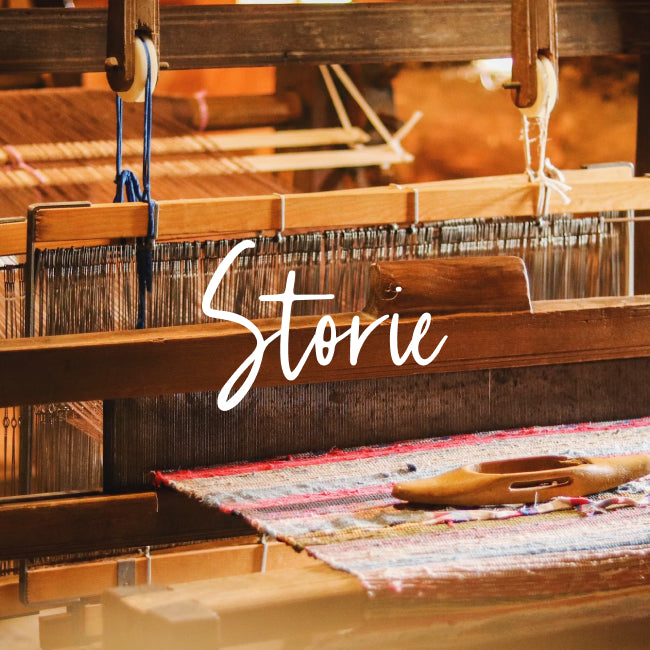As the printers wooden block makes contact with cloth, there is a slow, repetitive, deep thud of the stamp inside the craftsman’s atelier. A pattern is built up across a length of fabric, using a series of woodblocks, each with its own motif and colour. The work is time consuming and demands great precision.

This technique of woodblock printing is known to have been used in India since at least the 12th century. The method is far older, and was found in other ancient civilisations such as China as early as the 3rd century, and Egypt in the 4th century from which point its use spread across the world. Its beautiful results have also led to the craft being adapted by other neighbouring communities; we've recently visited a workshop in Bangladesh where a lively contemporary take on this tradition has taken off.

The process is long, and requires several different elements of craftsmanship. The first step is carving the stamp, this process is learnt over generations. The design is traced onto a planed slice of wood, which will then be chiselled and carved until a perfect block print is ready. A length of fabric may require many different blocks with separate elements of the design, and will each be applied in turn with their own colours. A simple design might use 3 blocks, but something more complicated could use up to 30 different blocks. Often a border design will be entirely separate and this might require another set of carved wooden blocks.

Before a cloth can be printed, it needs to be treated, dried and then ironed out flat onto long tables. If the artisans are using natural dyes the process will be different to synthetic dyes. Only after all these steps does the printing process begin.
This ancestral technique has been admired and reinvented over many generations and our enthusiasm for these prints does not seem to dwindle.
Today Storie is working with several different groups of block printers. One near Jaipur in India, which specialises in ancient natural dyeing techniques, using colours such as indigo and madder red.

They use a mix of mud, gum and wood chip to create the pattern.

We’ve also chosen to work with Jamini, a young Franco-Indian design team, who have successfully re-imagined woodblock print on textiles, bringing a contemporary palette and motifs to this much loved craft.

I talked to the founder of Jamini, Usha Bora, and asked where inspiration for their fantastic colours come from. She tells me it’s a real mix, “That’s my half French, half Indian brain. These colours are not something you see in India: but our autumn/ winter tones aren’t European “winter” colours either. I often go against the grain…. I feel you need colour in winter.” And the same goes for the patterns, “you’ll see irises in this collection, they don’t grow in India. That’s my French brain.”

Usha Bora lives in France, but she is of Indian origin, and this pretty mix of influences in her work, is very much born from her own life experience,
“I never really knew I would end up doing this, I worked in business and when I had my first child here in France, I asked myself what I wanted to do, and how I wanted to live my life. I wanted to find a way to build a bridge with my country (India)….with my family and friends who seemed so far away. In the north, Assam, where I am from there is this beautiful weaving. It wasn’t something we’d seen much in Europe. I wanted to put the focus back on our beautiful Indian craft… other brands do use weaving but the focus isn’t on craft. The designs developed from weaving to block print, as weaving is so time consuming. I still do a part of the range which is woven, but we mainly work with block print.”

Having been so popular for so long, I ask if there is a certain amount of reproduction in these contemporary block print designs “It’s an evolution. 80% of our prints are new. Some are older ones. In a collection of 10 designs, 6 or 7 will be ours.” On pieces inspired by older designs, they play around with colours and details.
With so much incredible Indian craft to choose from, why did Jamini focus on block print, Usha explains it’s to do with the small imperfections, or differences in every print, “today so much is “cloned….. we see the same stores on every street. Having something handmade, someone's touch to it makes it special, it's imperfect, I like that.”
Something unique, something with a human touch, perhaps a small irregularity to prove it, as is true of so many crafts.
Usha explains that it’s very difficult to replicate a design with this technique “The weather, the humidity, the pressure of a hand, all these factors are always a little different and that affects the finish. I feel these pieces are very personal. The process is so fascinating to watch. The artisans have learnt from one generation to another. We should be doing everything we can to preserve these crafts, if we don’t help preserve these traditions then they will disappear forever.”
Sources
Interview with Usha Bora of Jamini, September 2022
“Traditional Indian Textiles” Thames and Hudson by John Gillow and Nicholas Barnard
http://www.vam.ac.uk/content/exhibitions/the-fabric-of-india/textiles-in-a-changing-world/
https://www.johnsteins.com/woodblock-printing.html/
And special thanks to Nawshin Khair and the team at Aranya for showing us their block printing workshop in Dhaka.






